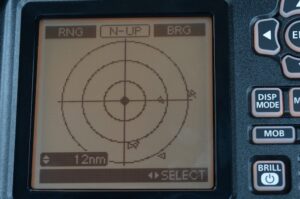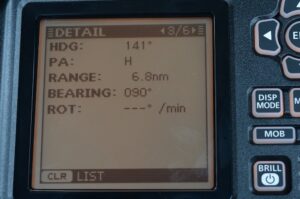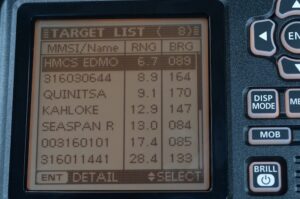Stay Extra Alert with Automatic Identification System (AIS) Tech
Knowing other boats’ vital navigation information provides safer experiences on busy waterways.
There’s nothing more enjoyable than cruising on a warm, bright summer’s day with family or friends, whether you’re taking a casual spin around a bay or enjoying a week-long trip.
However, sometimes carefree outings may be marred by misfortune – possibly with tragic consequences. Every year on North American waterways there are nearly 5,000 accidents involving pleasure craft or collisions with fixed objects such as docks, floating navigation aids, rock outcroppings, etc.
So, how can this be prevented?
Boating safety organizations such as CanBoat and The Canadian Safe Boating Council offer education and awareness programs in efforts to reduce these accidents. There are also a variety of modern electronic tools that offer excellent navigation as well.
All boats are equipped with at least one collision avoidance system and that is the person manning the helm. Staying alert with your eyes and ears is emphasized by the CanBoat and an oblique reference to Rule 5 of the Collision Regulations by Transport Canada. Unfortunately, human attentiveness can be hindered by distracting onboard socializing, fatigue, stress, etc.
Fortunately for recreational boaters, the electronic equipment industry continues to offer several relatively low-cost navigation, collision avoidance, radio communication, and other important safety-related devices and systems. Most of these tools were originally designed for large cargo and passenger commercial vessels, but equipment manufacturers have considered pleasure boaters’ needs as well. One of these units is an Automatic Identification System (AIS).
What is an AIS?
An AIS transponder is a transceiver that operates in the same part of the radio frequency spectrum as a Very High Frequency (VHF) marine radio. Transponders work autonomously; as long as the unit is on, the system actively operates, even when you’re at anchor. At timed intervals, they transmit two data packages that contain the same information about your vessel that is already programmed into your VHF/DSC radio (if you already have one).
For example, the data packages are identified by the same Maritime Mobile Safety Identity (MMSI) that is programmed into your VHF radio. At the heart of the unit is a GPS that supplies your boat’s positioning information so other AIS-equipped vessels in your area will receive that information. Since other AIS transponders are transmitting data packages, your unit also receives and displays their information.
AIS transponders are available in two classes, Class A and Class B. Class A units are mandated by the International Maritime Organization (IMO) for most large commercial vessels and transmit 12.5 watts of output. They have several other features as well given their size.
Class A data packages also contain additional information that is transmitted at higher frequency intervals than Class B units. While Class A transponders are available to use for a recreational boat, they are more expensive. Nevertheless, many enthusiasts who frequently cruise areas with restricted visibility and heavy commercial traffic will use a Class A unit.
However, Class B transponders are perfectly suited for most recreational boats. A Class B operates at 2 watts with a range of approximately 13 km (8 mi). The static data package is transmitted by the Class B transponder every six minutes and contains the MMSI, the vessel’s name, radio call sign (if you have one), vessel type, beam, and length. A Class B dynamic data package is transmitted every 30 seconds when the vessel is travelling at more than two knots and every three minutes if travelling less than two knots.
All AIS-equipped vessels – recreational or commercial – within range are displayed as boat-shaped icons (on most units) and you can highlight any vessel of interest. Some other information that is relayed includes:
- Course Over Ground (COG) related to True North and Speed Over Ground (SOG)
- The position and the bearing
- Speed and direction of travel
- Closest Point of Approach (CPA) and Time of Closest Point of Approach (TCPA).
This data is all processed by the transponder on various internal displays on the AIS system, providing essential information for safer navigation.



AIS Options
If you do your boating in an area where there isn’t a lot of large commercial traffic or the cost of a complete AIS transponder is beyond your budget, there are low-cost alternatives. Stand-alone single or dual-channel Class B receivers are available or you can purchase a VHF/DSC marine radio with an integrated Class B AIS receiver. But it’s always best to speak with your dealer to find the right unit/model for your needs.
It’s important to remember that if you are using a receive-only AIS unit, you will just see other vessels that are fully AIS-equipped but they won’t see you since you are not transmitting a data package. Also, keep in mind that many recreational boats are not yet AIS-equipped so it’s always still important to stay alert at the helm.
Understanding AIS and VHF Antenna Systems
The best AIS transponder in the world won’t work to its maximum efficiency if it’s connected to an improper or poorly maintained antenna. An AIS system requires two; one for the GPS and the other for the transmitter-receiver.
Antenna systems are designed for the frequency the equipment operates at (you can’t just connect any antenna to your equipment and expect it to work properly). Since AIS transponders and VHF radios operate in the same part of a radio frequency, you can use two separate antennas or just one with a special signal splitter. Do not use a Y-connector or a homemade splitter. Again, it’s best to speak to your dealer about your options.
If you decide to use two separate antennas, they must be spaced apart by at least 2m (7 ft), the VHF antenna should be placed as high as possible and away from high traffic areas on your boat, and the AIS antenna needs to be mounted in a good clear location.
The 50-ohm coaxial transmission cable that connects the antenna with the AIS unit – as well as the screw-on connectors – are other important parts of your AIS system. Be sure to keep them clean and free of any oxidation and use a low-loss cable in the event you have to run more than 6 m (20 ft) of cable between the two units.
AIS technology is very effective when cruising busy waterways. If you don’t have the knowledge and/or experience with marine electronic equipment, resort to a professional to find the best system and options to stay safe for the type of boating that you enjoy.
Learn more about AIS and VHF Radio Operation by signing up for our Maritime Radio Course at: www.boatingcourses.ca
By: Brian Reis CanBoat / Blue Mountain
